Restaurant competition is cutthroat, and being unique online takes more than fantastic food – it takes restaurant SEO. Since the majority of diners are using search engines to decide where to dine, having a solid SEO strategy gets your restaurant website listed in local search results, brings in more customers, and generates reservations or online orders.
This guide is built on proven search engine optimization practices tailored for restaurants. Drawing on real-world experience from optimizing restaurant websites, it covers everything from setting up a Google Business Profile to building online visibility with reviews, local directories, and content marketing. By following these restaurant SEO tips, you’ll not only improve your rankings but also earn the trust of potential customers searching online.
Whether you own a fine dining restaurant, a family café, or an expanding chain, these tactics will assist you in building a solid, reliable online presence that drives conversions.
What Is Restaurant SEO?
Restaurant search engine optimization (SEO) is the act of enhancing a restaurant’s website and online presence to rank higher in search engine listings whenever individuals search for where to eat. Rather than relying solely on word of mouth and conventional forms of advertising, restaurant SEO makes sure your company is where eaters are looking – on Google, Bing, and other search engines.
These platforms determine search engine rankings based on signals such as website speed, mobile usability, keywords, content quality, and reviews. For restaurants, this translates to factors like an optimized online menu, correct business listings, and positive customer feedback, directly affecting visibility.
In contrast to blanket digital advertising, restaurant-targeted SEO is built to grab local intent. The goal isn’t merely to drive more traffic but to drive visitors to reservations, online orders, or visits. By optimizing your restaurant’s online presence for how customers really search, search engine optimization (SEO) becomes one of the strongest tools to drive steady growth.
In brief, SEO for restaurants integrates effective search engine optimization techniques with the business needs of the restaurant industry to assist owners in drawing more neighborhood customers at the very time they’re looking online.
Why SEO Matters for Restaurants in 2025
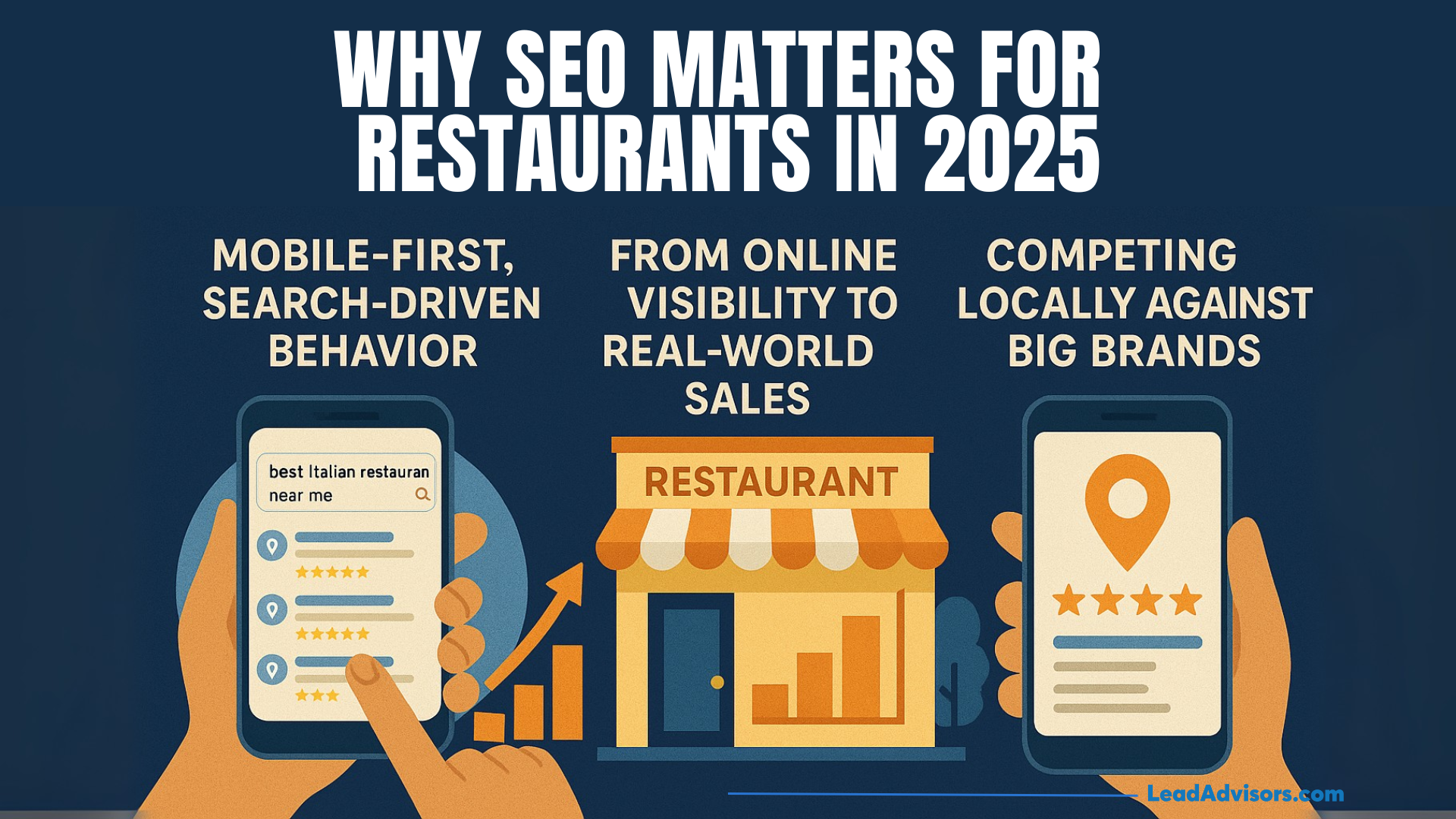
- Mobile-First, Search-Driven Behavior
The majority of diners start by searching online prior to making a decision about where to dine. Search terms such as “best Italian restaurant near me” or “vegan restaurants in [city]” are controlled by mobile users. If your restaurant’s online presence isn’t optimized, you’re likely to miss out on customers at the very moment they’re ready to decide. - From Online Visibility to Real-World Sales
Good SEO for a restaurant produces quantifiable results. Better search rankings translate into greater foot traffic, greater online ordering, and eventually more sales. Unlike paid efforts or third-party apps that cost repeat fees, SEO produces lasting visibility that continues to bring in prospects long after the work is completed. - Competing Locally Against Big Brands
A robust SEO plan enables individual restaurants to compete with big chains. Take a local Italian restaurant, for instance, with an optimized Google Business Profile, favorable online reviews, and a responsive restaurant website. That restaurant can outrank a famous chain in local search. Local visibility becomes actual customers walking through the door.
Why 2025 Makes SEO Essential
With increasing competition and increasing numbers of diners using search engines for quick options, SEO is no longer an option but a necessity. Restaurants that prioritize optimization will be the ones diners see, believe in, and opt for – time and again.
Local SEO for Restaurants – The Key to Success
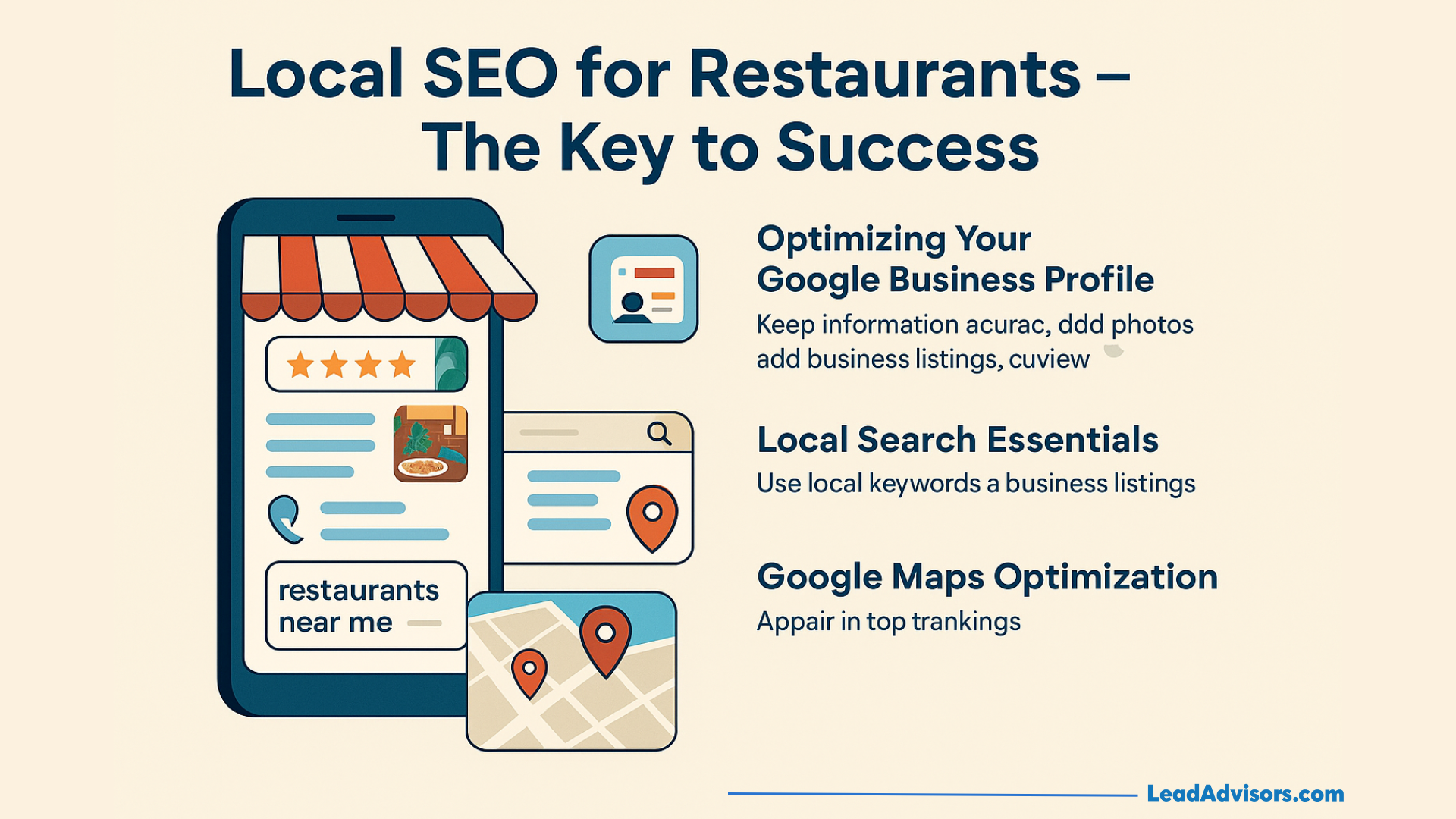
If a person searches “restaurants near me” on Google, the first businesses that show up almost inevitably get more diners, more phone calls, and more take-out orders. That visibility is the result of excellent local SEO, which allows restaurants to reach out and touch adjacent customers at the very moment when they are looking.
Optimizing Your Google Business Profile
Your Google Business Profile is the backbone of local SEO. Claiming and verifying it means you manage how your restaurant shows up in search. Keep key information such as address, phone number, hours, and links to your restaurant website or online ordering system up to date.
Top-quality photos of your menu items and dining area make your listing more attractive, while good online reviews enhance local search rankings and establish trust with prospective customers.
Local Search Essentials
Outside of Google, consistency is key. Incorporate local keywords into your website titles, descriptions, and menus to reflect the way customers search. Ensure your restaurant is listed in trustworthy business directories, local directories, and review sites like Yelp or TripAdvisor. Having consistent information on all platforms makes it easier for search engines to establish your credibility and increase visibility in local search results.
Google Maps Optimization
Ranks high on Google Maps – particularly in the top three “map pack” listings – can send a lot of traffic. Placement is determined by proximity, relevance, and reputation, so restaurants with fully filled-out profiles, proper categories, and consistent flows of reviews tend to rank highly. Including descriptive services (like fine dining, vegan, or family restaurant) makes your profile align with what diners are looking for in real time.
Good local SEO combines visibility, credibility, and trust. With a well-managed Google profile, directories, and maps presence, you put your restaurant forward as the natural choice in your community.
On-Page SEO for Restaurant Websites
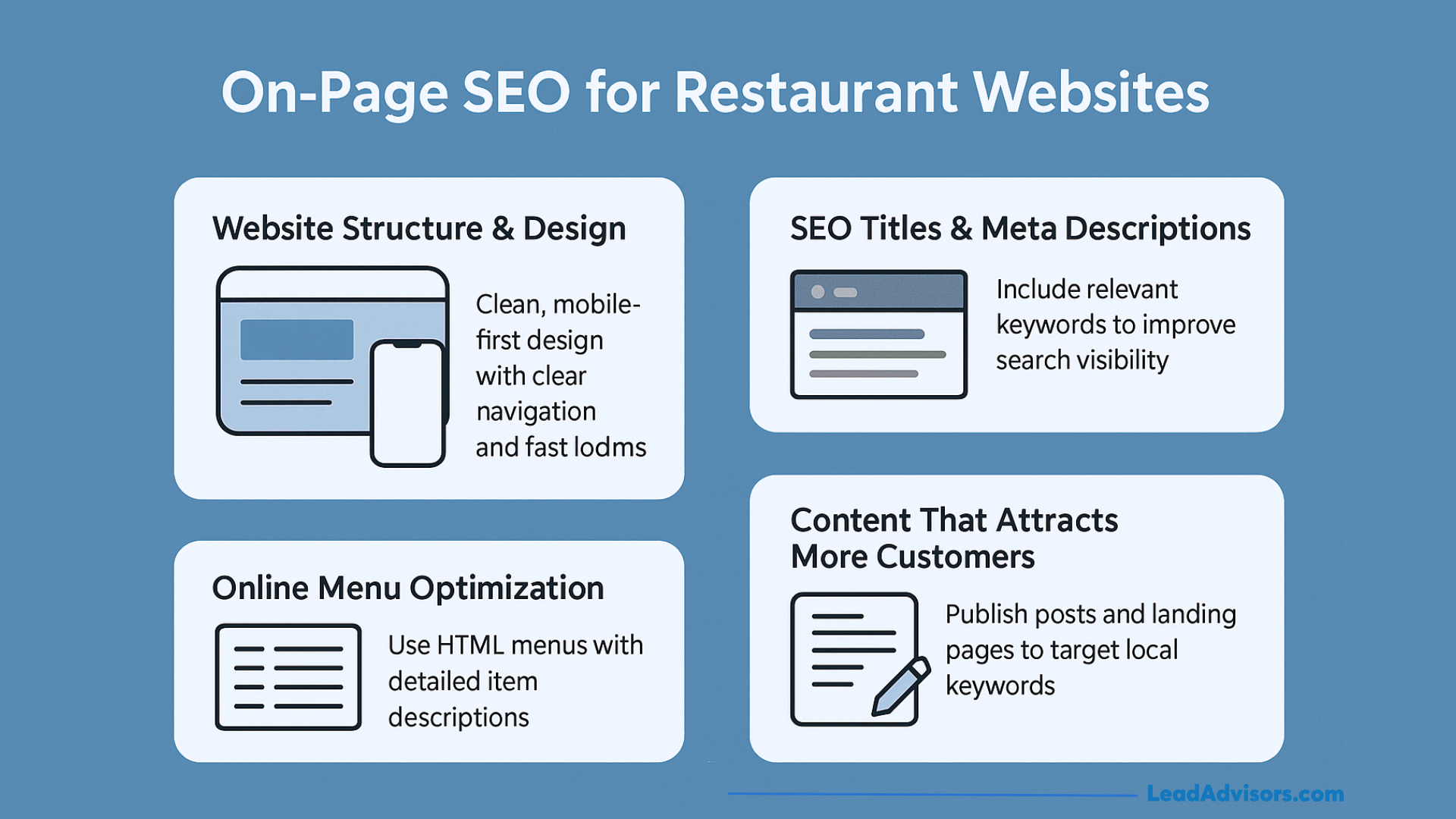
A restaurant site optimized well is the anchor of any SEO plan. Not only do on-page enhancements make it more accessible for search engines to comprehend your content, but they also make it easier for visitors, and that translates into higher chances of reservations or takeout orders.
Website Structure & Design
Your website must have a clean, mobile-first layout as the majority of your customers search on their smartphones. A well-organized site structure – with intuitive navigation, quick loading, and easy-to-find contact details – benefits users and search engines alike. Having must-haves such as hours, directions, and reservation links on all pages establishes credibility and calls users to action.
SEO Titles & Meta Descriptions
Every page must have a distinct SEO title containing relevant keywords, e.g., “Italian Restaurant in Chicago” or “Family Restaurant with Online Ordering.” A well-crafted meta description behaves like an ad miniaturization in search engine results pages, increasing click-through rates and informing customers why your restaurant is the way to go.
Online Menu Optimization
Menus are frequently the most viewed thing by customers. Rather than posting them as PDFs, use HTML and schema markup so search engines can index and show your web-based menu directly in search results. Rich menu descriptions, including local and cuisine-style keywords (like vegan, fine dining, or Mexican), assist in grabbing niche searches as well as lead hungry customers to precisely what they’re seeking.
Content That Attracts More Customers
Posting regularly confirms your restaurant website is active and in authority. Seasonal specials, local events, or “best-of” guides published as blog posts provide you with increased opportunities to appeal to local keywords. Special landing pages for specific niches – such as Italian restaurants, vegan restaurants, or family restaurants – can assist in reaching a larger audience and bringing more customers from organic searches.
Strong on-page SEO combines optimization and usability. If your site is well-navigated, keyworded, and backed by good content, it not only ranks higher but also converts random visitors into regular diners.
Building Authority with Content & Backlinks
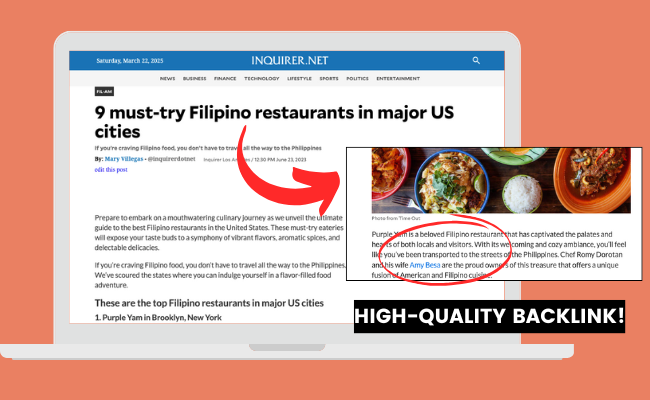
Ranking high in search engines is not about having a nice restaurant website, but also about demonstrating that your restaurant is authoritative and trustworthy. Content and backlinks are critical to demonstrating to search engines that your business should have higher search engine rankings.
Keyword Research & Content Strategy
Solid content starts with aggressive keyword research. By finding the relevant keywords, restaurants can appeal to the precise phrases actual consumers search for. For instance, a page centered on “best Mexican restaurant in [city]” taps local intent and draws diners searching using definitive buying signals.
In addition to niche terms, material should additionally address seasonal cuisine, regional events, or current topics on the restaurant scene. Regularly posting this kind of material indicates proficiency and increases long-term online search presence.
Backlink Building for Restaurants
Links from authoritative sites are like confidence votes in the eyes of search engines. Obtaining quality backlinks and pertinent backlinks can greatly enhance local SEO rankings. Restaurants can obtain these links by:
- Working with food bloggers to list menu items or reviews.
- Partnerships with local media or other businesses for cross-promotions.
- Running community events and making sure they’re reported on online.
All of these not only help fortify SEO but also increase your exposure to prospective customers who might not have otherwise stumbled upon your restaurant.
Leveraging Social Media Engagement
While likes and shares are not direct ranking factors, strong social media engagement increases brand awareness and indirectly supports SEO. Content shared on platforms like Instagram, Facebook, or TikTok can earn attention from local influencers or journalists, often leading to relevant backlinks. Active engagement also reinforces your restaurant’s online visibility, helping searchers trust your brand when they see it across multiple platforms.
By merging targeted content, strategic backlinks, and a social presence, restaurants can gain authority both online and offline – making it simpler to rank higher and turn visitors into paying customers.
Restaurant Technology & Online Ordering SEO
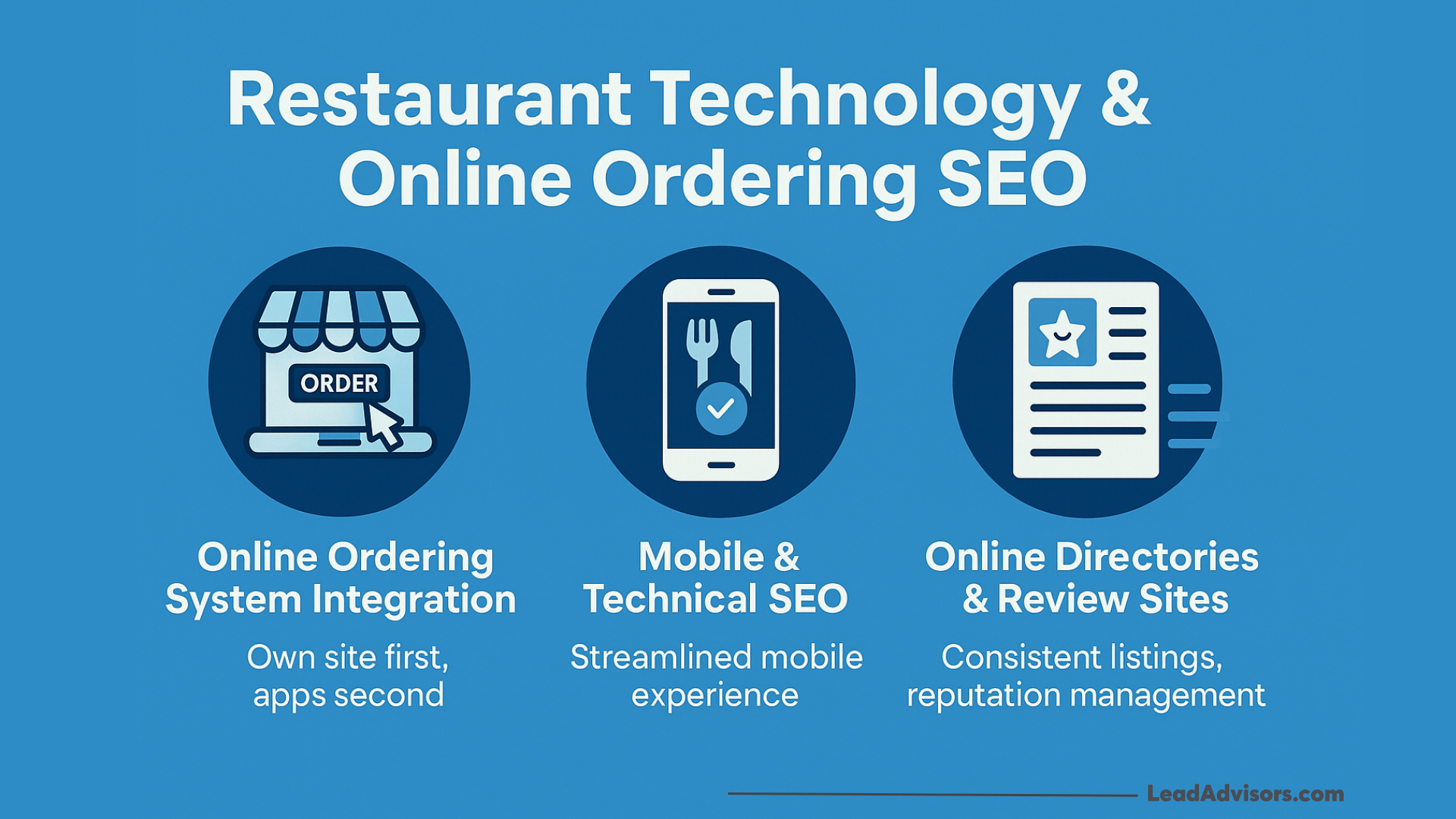
Technology is playing an increasingly large part in how restaurants reach out to prospective customers, and search engines increasingly encourage businesses that offer a seamless digital experience. From online ordering systems to mobile performance, the correct setup can significantly enhance a restaurant’s visibility and conversions.
Online Ordering System Integration
Your website ordering system not only processes transactions – it can impact SEO too. When people order directly on your own site, you retain complete control over traffic, information, and visibility. This configuration bolsters your restaurant’s web presence and makes it simpler for search engines to connect your brand to core services.
Conversely, depending on apps such as DoorDash or UberEats can create revenue, but too frequently results in losing organic traffic and backlinks to their websites. A balanced strategy – apps second, own site first – provides the best of both worlds.
Mobile & Technical SEO
Mobile optimization is not optional. The majority of diners view menus, reviews, and orderability on their mobile devices, so slow performance loses sales. Robust technical SEO, such as quick site load times, tidy code, and Core Web Vitals optimization, makes your website for a restaurant perform optimally. An efficient mobile order process not only enhances customer experience but also communicates quality to search engines, sending your rankings up.
Online Directories & Review Sites
Visibility on review websites and online directories such as Yelp, TripAdvisor, and DoorDash merchant pages also enhances SEO. Many of these sites tend to rank high in local search results, providing your restaurant with secondary visibility when your site isn’t the first click. Regular listings, precise NAP information, and ongoing reputation management all work together to create improved rankings and increased credibility for both diners and search engines.
By merging technology with optimization, restaurants can enhance their digital infrastructure, drive more customers, and turn online inquiries into paying orders and in-world visits.
Tracking SEO Results for Your Restaurant
Operating a campaign without monitoring is like cooking without sampling – you won’t know what is effective. Monitoring SEO performance indicates if your restaurant is indeed becoming visible, attracting more visitors, and generating more sales from organic search.
Using Google Analytics
Google Analytics is perhaps the single most useful resource for restaurant operators. It measures organic traffic, clicks, and conversions so you can understand how individuals discover and use your restaurant site.
In addition to visits, you can track actual results like online reservations, phone calls, and fulfilled orders through your online ordering system. Establishing goals in Analytics makes it easier to connect seo performance directly to revenue, allowing you to more easily demonstrate ROI and optimize your local SEO strategy.
Monitoring Search Engine Rankings
Traffic is only part of the tale, but tracking search engine rankings shows you how effectively your site is ranking in local searches. Google Search Console, SEMrush, or Ahrefs are tools that assist in tracking where your restaurant is ranking for valuable keywords – for example, “Italian restaurant near me” or “family restaurant with online ordering.”
Looking at rankings over time enables you to notice trends, bask in successes, and see what you should work on. If keyword research begins to dip, tweaks to your content, seo titles, or backlinks could be implemented to restore visibility.
By joining Analytics with ranking tools, restaurants are able to make informed decisions that guarantee their SEO efforts always lead to paying customers and sustainable growth.
Advanced Restaurant SEO Strategies
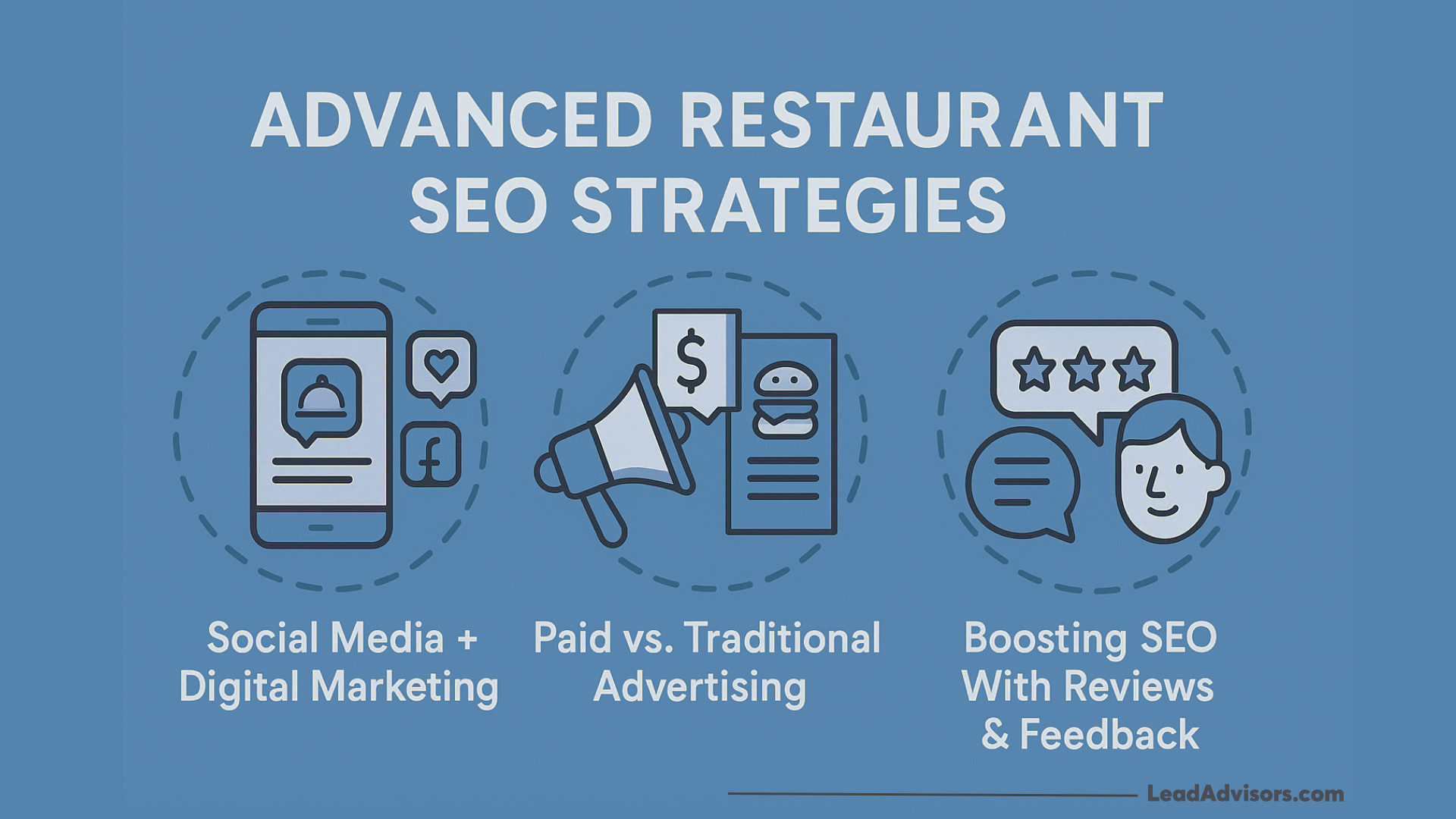
With the fundamentals of SEO for restaurants established, advanced tactics can set your business apart in competitive markets. They move beyond technical solutions and local citations to build a robust, credible brand that search engines and consumers alike know and recognize.
Social Media + Digital Marketing
Digital marketing is also essential for magnifying SEO outcomes. Social media activity does not impact rankings, but it raises awareness and stimulates engagement that enhances your restaurant’s online presence.
Menu cross-promotion across Instagram, TikTok, and Facebook can create buzz, send traffic to your restaurant website, and create solid signals like backlinks or mentions from local influencers. The more people share and talk about your content, the better your brand authority is.
Paid vs. Traditional Advertising
SEO is powerful, but pairing it with paid advertising can create an even stronger funnel. Google Ads or social media campaigns can generate quick visibility while SEO builds long-term results. In contrast, traditional advertising methods – such as flyers, billboards, or print ads – still have value but won’t sustain growth on their own. The most effective restaurants use a hybrid strategy, combining SEO with paid campaigns to capture both immediate and long-term demand.
Boosting SEO With Reviews & Feedback
Customer reviews are one of the most powerful signals for search engines and prospective diners alike. Regularly gathering and responding to online reviews demonstrates credibility, and high ratings enhance local search visibility. Driving social media engagement – tagged photos, shares, and comments – fosters community trust and reinforces your reputation across channels.
These innovative techniques collectively turn SEO into a multifaceted growth driver from its humble beginnings as a visibility strategy. By using social engagement, advertisement, and reputation control in tandem, restaurants can achieve healthier rankings, drive more traffic, and keep their competitive advantage in position well beyond 2025.
Real-Life Restaurant SEO Examples
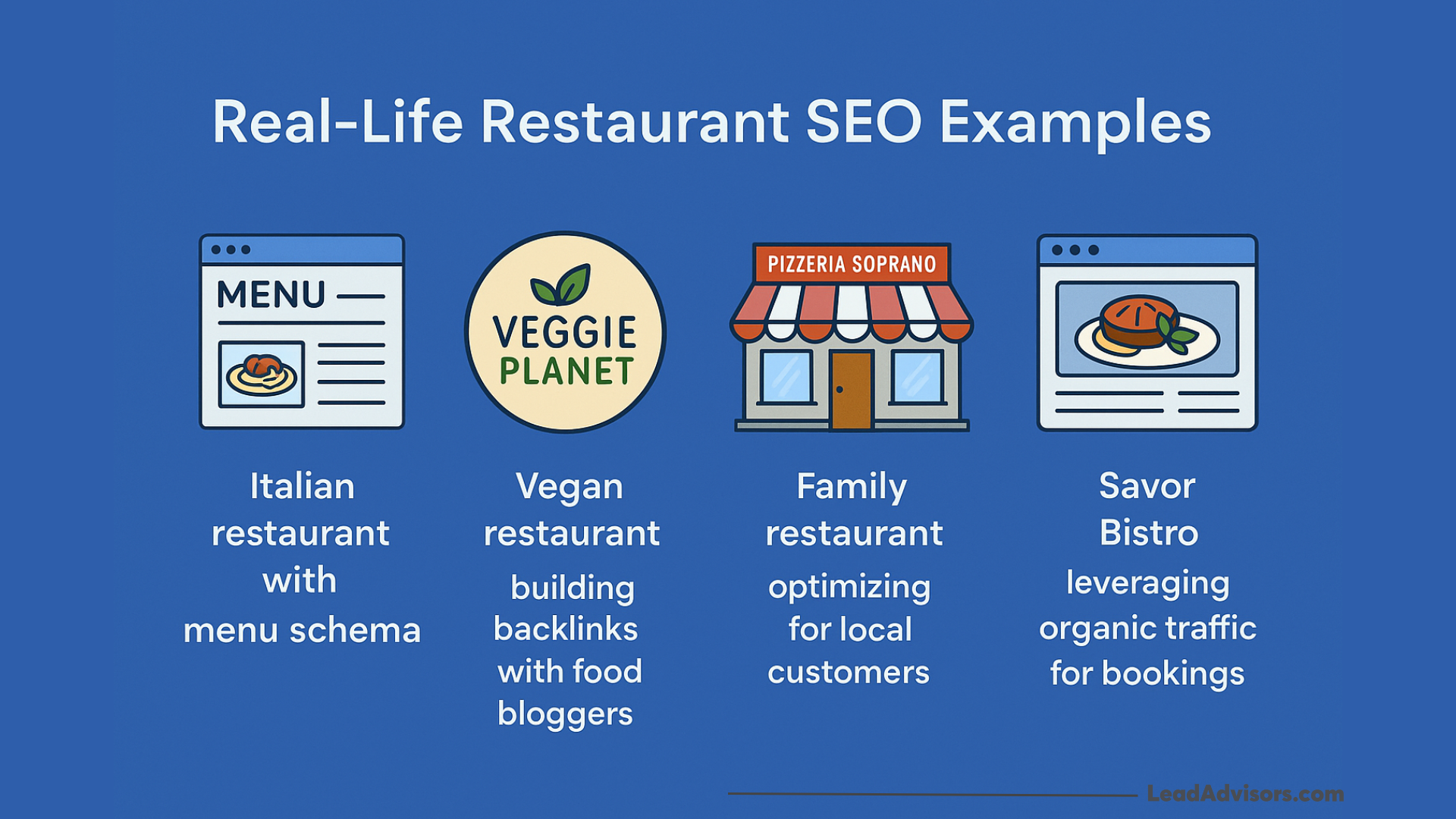
The most effective way to realize the effects of SEO for a restaurant is by looking at real-life outcomes. These mini-case studies illustrate how various restaurants have used strategies to increase visibility, snag organic traffic, and turn searchers into paying customers.
Italian restaurant with menu schema
A standalone Italian restaurant utilized menu schema markup to improve its restaurant site. With the addition of structured data for dishes such as names, prices, dietary information, and images, the restaurant achieved rich snippets in search. In addition to increasing click-through rates, this provided customers with the assurance that menu data was correct and current, thereby leading to increased bookings.
Vegan restaurant building backlinks with food bloggers
Veggie Planet, a Mississauga vegan restaurant, joined forces with influencers and bloggers to reach more people. By running backlink campaigns, optimizing its website, and engaging on social media, the restaurant rose to the top of the local search page one. The increase in relevant backlinks and online reviews resulted in greater exposure, increased leads, and better brand awareness.
Family restaurant optimizing for local customers
Pizzeria Soprano emphasized local SEO by advertising neighborhood-specific terms and optimizing its Google Business Profile. Online orders increased by 18% within a few months, conversions by 29%, and revenue by 26%. Although total visits decreased, the traffic was more relevant and valuable – demonstrating that local customer optimization generates quantifiable results for family restaurants.
Fine dining restaurant leveraging organic traffic for bookings
Savor Bistro, a restaurant with fine dining, employed a multifaceted SEO approach: keyword research, content marketing (chef interviews and spotlighting signature dishes), and mobile optimization site enhancements. Through the fortification of both on-page and local search factors, they experienced steady organic traffic growth and an impressive increase in reservations, even in a very competitive market.
These instances indicate that SEO success is not restaurant type-constrained. From casual dining to high-end dining, the correct strategy – whether structured data, backlinks, or local search optimization – can produce tangible results.
Restaurant SEO Tips and Checklist
You don’t need to do a total restaurant SEO overhaul to make your restaurant’s online presence better. Making small, regular changes can have dramatic effects. Here are some fast-hit restaurant SEO tips to start:
- Regularly update your Google Business Profile with up-to-date hours, menus, and photos.
- Use local keywords (such as “family restaurant in Dallas” or “vegan café in Brooklyn”) throughout your restaurant website.
- Invite happy customers to post online reviews to enhance trust and local search visibility.
- Optimize your online menu with structured data rather than posting as a PDF.
- Optimize SEO titles and meta descriptions with keywords for better click-through rates in search results.|
- Optimize site speed and responsiveness to enhance technical SEO.
- Construct quality backlinks by reaching out to food bloggers or supporting community events.
Effective Restaurant SEO Strategies Checklist
For easy reference, here is a brief list of successful restaurant SEO tactics:
- Claim and optimize your Google Business Profile.
- Add consistent business listings throughout local directories.
- Optimize your restaurant site with keyword-rich titles and structured menus.
- Manage customer reviews and feedback actively.
- Create fresh, local content at least once a month.
Begin by selecting three of these strategies to implement this week. Small changes – such as refreshing your menu online or asking for a few reviews – can improve visibility, attract more customers, and lay the groundwork for long-term SEO expansion.
Frequently Asked Questions
How much does restaurant SEO cost?
How to optimize a restaurant website for SEO?
How long does it take to improve local search rankings?
Do I need an SEO agency, or can I DIY?
Final Thoughts
Powerful restaurant SEO is no longer a choice – it’s the basis of visibility and expansion in 2025. By optimizing your website for restaurant, claiming your Google Business Profile, and targeting local search results, you establish the path towards more traffic, more consumers, and finally, more sales.
The most effective restaurants make SEO an ongoing process, not a single event. Search engines change daily, customer behavior evolves, and competitors shift – so staying current keeps your strategy yielding results.
Whether you begin small by optimizing SEO titles and asking for reviews, or invest in an overall approach with content, links, and technical enhancements, steady action will establish your restaurant as the go-to choice in your neighborhood.
Invest in SEO today, and your restaurant won’t just be discovered online – it will be selected, visited, and remembered.












